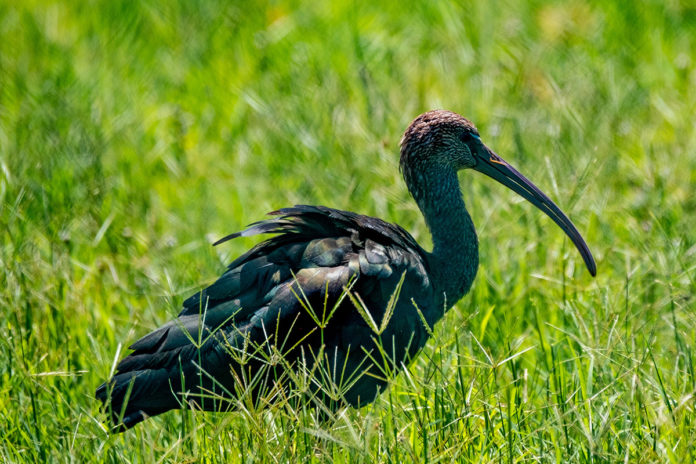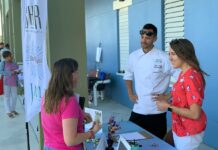It was the iridescence that gave the bird away, the dusky gleam that made it look black but also, at the same time, a shifting palette of burgundy, purple and green.
Honestly, I didn’t trust the gleam at first, just suspected it.
Most of the birds I was seeing were white ibises, and most of them were adults, white with long, arcing, sickle-shaped bills in varying intensities of red. (The redder they get, the more hormonally ready to breed they are.) There were a good number of younger birds, though – mostly brown, living through their first summer, birds with brown heads but bodies turning to white living through their second summers.
White ibises are one of the more ubiquitous species in Florida, and fairly common all around the Gulf Coast and Caribbean. They seem pretty comfortable anywhere – golf courses, beaches, swamps, marshes, parking lots and, sadly, the occasional Dumpster. (Egyptians have a god named Thoth who has the body of a man and the head of an ibis, but may have reconsidered had they known about their Dumpster-diving tendencies.)
The birds I was seeing were, to my mind, in one of the more ideal situations for them – the fenced-off grass at the base of the FAA tower near Higgs Beach, which is generally free from human or canine interruption. And it had rained a day or two before, so the whole area was flooded like a private, little, grassy swamp.
Ibises feed by shoving those long, curving bills down into the ground, hunting for crustaceans, grubs, worms and other subterranean invertebrates. They have bundles of nerves in the tips of their bills to help them feel prey in places they cannot see. With the ground as waterlogged as it was, it no doubt made all that poking and probing easier, and there seemed to be something of a frenzied and buoyant mood in the flock.
At first I wasn’t sure about the iridescence. The bird was far back, on its own and away from the flock. It seemed like a wide open habitat, but the grass must have been higher than it looked because the bird kept appearing then disappearing behind the bigger clumps. It was possible it was just an immature white ibis in weird light and I’d given the impressionistic, seat-of-the-pants part of my brain a little too much rein.
I tried to get a decent shot of the bird with my camera, but between the chain link fence and all the rogue stalks of grass everywhere, the autofocus was hunting and seeking in all the wrong places. It wasn’t the iridescence I was trying to capture. Like a black light poster, that stuff never conveys to a camera the way it does to a human eye. I was trying to get a shot of the bird’s belly to make sure there wasn’t any white in there, to confirm my suspicions.
Finally I gave up and went old school, and just followed the bird with my binoculars. And after some intense staring it turned out the impressionistic, seat-of-the-pants part of my brain was right – there was a low-key, multi-hued gleam to the feathers, making it a glossy ibis.
Birds’ plumages get their colors in two different ways, from pigments in the feathers – either genetically encoded or acquired through diet – or from structures in the feathers that refract light.
Glossy Ibis get their colors both ways. The blacks and dark browns of their plumage come from pigments, but the green/purple/burgundy soap bubble-like sheen comes from structural elements in their feathers that deflect different parts of the light spectrum. It’s best seen in real life, but an impressionistic bird painter, like David Sibley, does a far better job conveying what the human eye sees than a photo.
Glossy ibises are not the rarest bird in the world. They might be the most common and cosmopolitan of all the ibises, seen regularly on every continent but Antarctica. But this was not always the case.
The first glossy ibis recorded in North America was seen in 1817. John James Audubon included a painting of one in his Birds of America, but he only saw a single living glossy ibis in his lifetime. By the 1950s, though, they were considered somewhat common, the bulk of them living in Florida, with notable colonies upstate in places like Lake Okeechobee and the St. Johns River. And their territories have spread outside of Florida as far north as New Brunswick, Canada, and as far west as Louisiana. (Nothing I have ever read has posited that they got to the Americas by anything other than a natural range expansion, despite the suspicious circumstances of them showing up in a post-colonial era.)
Glossy ibis are not what you would call rare in the Keys, but they are uncommon and irregular. Standing outside the chainlink by the tower I couldn’t remember the last time I had seen one in the Keys. It had been a few years. I tried to remember the last time I had seen one up in the Everglades, and couldn’t come up with a distinct memory from there, either.
I followed the bird for a long time, sporadically taking shots. Twenty frames. A hundred frames. I watched it move toward all the white ibises and then mix in on their crustacean crunching scrum, and shot a few hundred more frames. Most of them were going to be garbage shots and I wondered why I felt so compelled to keep shooting.
I think I just really missed seeing the strange things those feathers could do to light. And until then I didn’t even know I missed it.


























